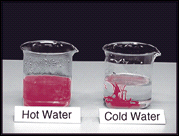|
Approach: Team
|
| Focus:
Developing and presenting
explanations for two temperature related phemomena: the changes in the state of
water and the rate of diffusion of dye in water. |
 |
92k |
Resources: Video
showing ice turning to steam and red dye diffusing in hot and cold water, 2 team
instruction cards.
 Download
the videoclip 3MB (requires QuickTime
plug-in) Download
the videoclip 3MB (requires QuickTime
plug-in)
|
|
Questions / instructions:
In this activity your team
is going to try to explain changes that happen to substances. We'll begin by watching
two video clips.
 Play
video. Play
video.
I want you to work out good explanations for these changes. You'll start off working
in pairs, then work as one team. [Names, students 1 and 2] will work on an explanation
for the clip about ice, water and steam. [Names, students 3 and 4] will work on
an explanation for the coloured water. Here are the instructions for what you
are to do.
Place instructions cards for all students to see, then read them to the team.
I'll give you a few minutes to work out your explanations in your pairs, then
we will work as a whole team. Allow time for discussion in pairs, the bring students
together for team discussion. I want each pair to tell the others their explanations.
The others should listen carefully, then comment on the explanation so that the
whole team agrees on the best possible explanation. After you have had time to
do that, I will ask you to tell me your explanations.
 Teacher
withdraws and allows time for team discussions. Teacher
withdraws and allows time for team discussions.
Now I would like [names, students 1 and 2] to tell me the team's explanation for
what happened with the ice, water and steam. After that I want [names, students
3 and 4] to tell me the team's explanation for what happened with the coloured
water. Make your explanations nice and clear so that I can fully understand your
reasons.
|
| |
%
responses |
|
y8
|
|
Ice
=> water
=> steam: |
|
a |
| |
refer
to heat melting ice |
71 |
|
refers
to heat making water boil |
37 |
|
explains
that ice becomes water as it melts |
67 |
|
explains
that water becomes steam as it boils |
75 |
|
refers
to phase changes or different forms of water (solid, liquid, gas) |
36 |
|
refers
to extra heat required at phase changes (latent heat) |
20 |
|
Dye
spreading in cold and hot water: |
|
a |
| |
observes
that dye spreads faster in hot water |
88 |
|
explains
spread due to faster, stronger currents (convection) |
17 |
|
explains
spread due to faster molecular motion (diffusion) |
21 |
Commentary:
Most of the year 8 student teams identified the phenomena presented on videotape.
Fewer succeeded in explaining these phenomena. |
 Play
video.
Play
video.  Teacher
withdraws and allows time for team discussions.
Teacher
withdraws and allows time for team discussions.